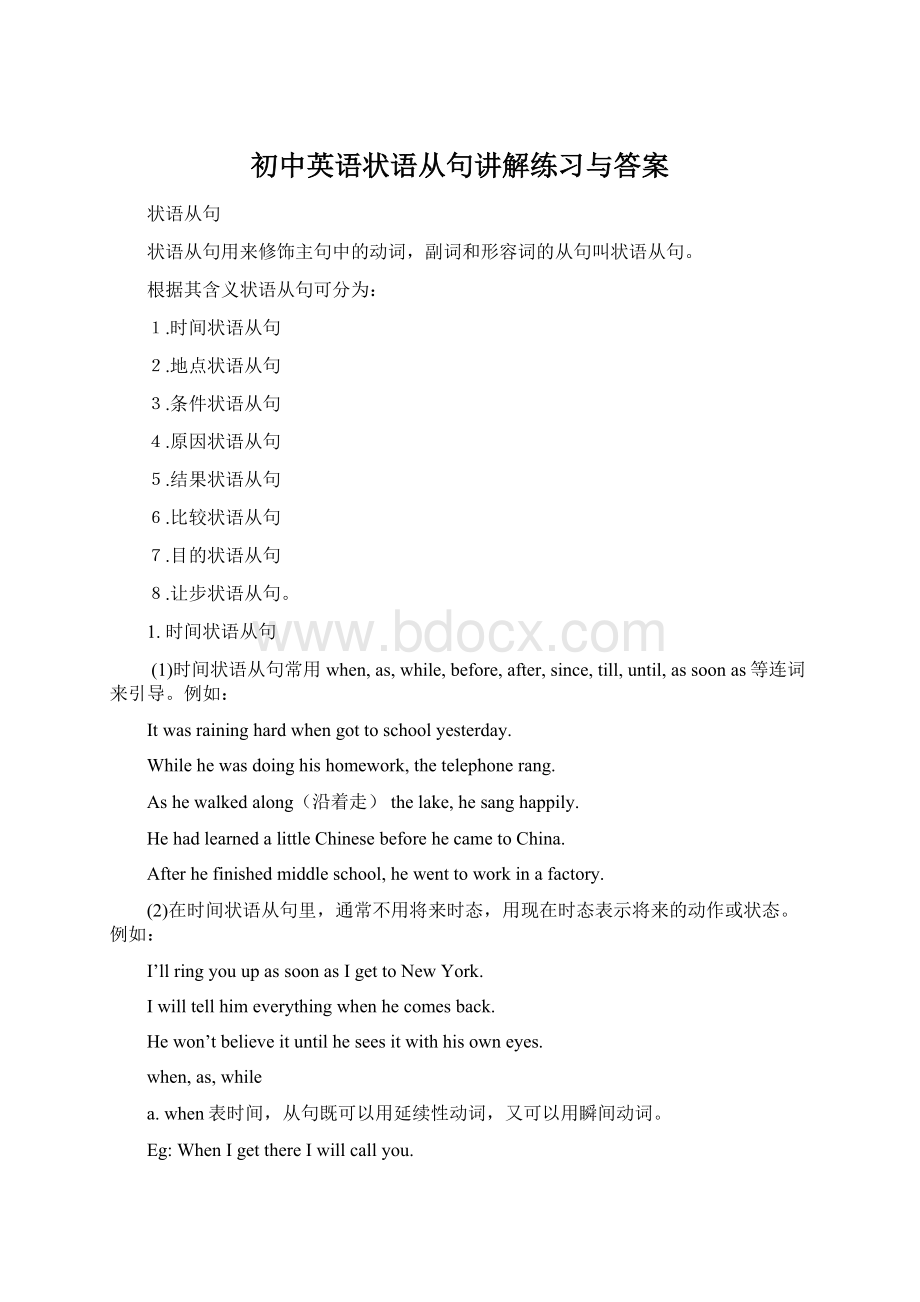初中英语状语从句讲解练习与答案.docx
《初中英语状语从句讲解练习与答案.docx》由会员分享,可在线阅读,更多相关《初中英语状语从句讲解练习与答案.docx(13页珍藏版)》请在冰豆网上搜索。

初中英语状语从句讲解练习与答案
状语从句
状语从句用来修饰主句中的动词,副词和形容词的从句叫状语从句。
根据其含义状语从句可分为:
1.时间状语从句
2.地点状语从句
3.条件状语从句
4.原因状语从句
5.结果状语从句
6.比较状语从句
7.目的状语从句
8.让步状语从句。
1.时间状语从句
(1)时间状语从句常用when,as,while,before,after,since,till,until,assoonas等连词来引导。
例如:
Itwasraininghardwhengottoschoolyesterday.
Whilehewasdoinghishomework,thetelephonerang.
Ashewalkedalong(沿着走)thelake,hesanghappily.
HehadlearnedalittleChinesebeforehecametoChina.
Afterhefinishedmiddleschool,hewenttoworkinafactory.
(2)在时间状语从句里,通常不用将来时态,用现在时态表示将来的动作或状态。
例如:
I’llringyouupassoonasIgettoNewYork.
Iwilltellhimeverythingwhenhecomesback.
Hewon’tbelieveituntilheseesitwithhisowneyes.
when,as,while
a.when表时间,从句既可以用延续性动词,又可以用瞬间动词。
Eg:
WhenIgetthereIwillcallyou.
如果when引导的时状的主语与主句的主语相同,而从句的谓语又是be动词时,那么从句中的主语与be可省。
Eg:
When(youare)introuble,youcanaskherforhelp.
如果when引导的时状的主语与主句的主语相同时,往往可以用“when+分词”的形式代替该状从。
Eg:
WhenIcameintotheroom(Whencomingintotheroom),Ifoundthelightwasoff.
b.while表时间,从句需用延续性动词,或者主句的动作发生在从句的动作进行过程中。
主句的谓语动词通常是非延续性动词。
Eg:
HecameinwhileIwasreadingabook.
ImetherwhileIwasinschool.
c.as表时间,与when相似,但侧重强调主从句动作同在时间点或同时间段进行。
同时可表示主句的动作随着从句的动作的变化而变化。
Eg:
Hejumpsashesings.
Asthewindrose,thenoiseincreased.
但是置于句首时只可用untill.
Untilyoutoldme,Ihadheardnothingofwhathappened.直到你告诉我以前,出了什么事我一点也不知道
4.assoonas/themoment/theinstant/thesecond/theminute/immediately和hardly/scarcely…when,nosooner…than
a.assoonas/themoment/theinstant/thesecond/theminute/immediately表示主句和从句的动作同时发生。
译为“一……就”
Eg:
Assoonassheheardthenews,shebegancrying.
b.hardly/scarcely…when,nosooner…than都可以表示"一……就……"的意思,但主句谓语动词一般要用过去完成时,从句谓语动词要用一般过去时。
Eg:
Ihadhardly/scarcelygothomewhenitbegantorain.Ihadnosoonergothomethanitbegantorain. 注意:
如果hardly,scarcely或nosooner置于句首,句子必须用倒装结构:
Hardly/ScarcelyhadIgothomewhenitbegantorain. NosoonerhadIgothomethanitbegantorain。
1. We called the First - Aid Center_______ the traffic accident happened.
A. immediately B. shortlyC.quicklyD. hurriedly
2. The roof fell _____he had time to dash into the room to save his baby.
A. before B. as C. after D. until
3.Agoodstorytellermustbeabletoholdhislisteners’curiosityhereachestheendofthestory.
AwhenBwheneverC.afterD.until
4. I had just started back for the house to change my clothes _______ I heard the voices.
A. as B. for C. while D.when
5.______thedaywenton,theweathergotworse.
A.WithB.SinceC.WhileD.As
2.条件状语从句
(1)条件状语从句通常由if,unless引导。
例如:
Whatshallwedoifitsnowstomorrow?
Don’tleavethebuildingunlessItellyouto.
2.incase,onconditionthat,provinding,provided(that),supposing,supposed(that):
“假如,在……条件下”
Eg:
ThemotherpromisestothesontobuyhimatoyairplaneonconditionthathepasseshisEnglishtest.
Suppose(that)hedoesnotcome,whatshallwedo?
Ex
1. --What are you going to do this afternoon?
--I’ll probably go for a walk later on ___ it stays fine.
A. as far as B. so long asC. even if D. as if
2.WewillhaveapicnicintheparkthisSundayitrains.
AsinceBifCunlessDuntil
3.Youwillpasstheexamyouworkhard.
AunlessBevenifCasifDif
(2)在条件状语从句里,谓语动词通常用现在时态表示将来的动作或状态。
例如:
3.原因状语从句
(1)原因状语从句通常由because,since,as,for引导。
例如:
Hedidn’tcometoschoolbecausehewasill.
Asitisraining,weshallnot(不得;不应该)gothezoo.
Sinceyoucan’tanswerthequestion,I’llasksomeoneelse.
(2)because表示直接原因,语气最强。
Because引导的原因状语从句多放在主句之后。
回答由why提出的问题,只能用because。
As和since语气较弱,一般用来表示明显的原因。
由as和since引导的原因状语从居多放在句首。
例如:
------Whyaren’tgoingthere?
------BecauseIdon’twantto.
Ashehasnocar,hecan’tgetthereeasily.
Sincewehavenomoney,wecan’tbuyit.
3.for–放句中,对前面一句话的内容的补充说明。
Fot引导的原因状语从句只能置于主句之后并且必须用逗号将其与主句隔开。
Eg:
Hecouldnothaveseenme,forIwasnotthere.
4.since/seeing(that)/now(that)/considering(that)/inthat–通常放句首.译为“既然”。
Eg:
Sincethepurserdidn’ttelluswhattodo,wecanrelax.
Ex.6
1.Hefounditincreasinglydifficulttoread,hiseyesightwasbeginningtofail.
AandBforCbutDor
2.–DidyoureturnAnn’scall?
-Ididn’tneedtoIwillseehertomorrow.
AthoughBunlessCwhenDbecause
4.结果状语从句
(1)结果状语从句由so…that,such…that,sothat引导。
例如:
Heissopoorthathecan’tbuyabikeforhisson.
Sheissuchagoodteacherthateverybodylikesher.
Mypencilfellunderthedesk,sothatIcouldn’tseeit.
(2)so…that语such...that可以互换。
例如:
在由so...that引导的结果状语从句中,so是副词,与形容词连用。
其结构是:
“...so+形容词(副词)+that+从句”。
例如:
Hewassogladthathecouldn’tsayaword.
Thehallissobigthatitcanhold2,000people.
Motherlivessofarawaythatwehardlyever(几乎不,从来不)seeher.
在由such…that引导的结果状语从句中,such是形容词,它修饰的可以是单数或复数可数名词,也可以是不可数名词;名词前面可以带形容词,也可不带。
如果是单数可数名词,前面需加不定冠词a或an。
例如:
such +a/an+9(形容词)+名字
Itwassuchahotdaythatnobodywantedtodoanything.
Hehadsuchlongarmsthathecouldalmosttouchtheceiling.(天花板)
Hemadesuchrapidprogressthathedidverywellinthemid-term.
有时上述两种结构是可以互换的。
例如:
Itwassuchawonderfulfilmthatallofuswantedtoseeitagain.
=Thefilmwassowonderfulthatallofuswantedtoseeitagain.
Itissuchanimportantmatchthatnobodywantstomissit.
=Thematchissoimportantthatnobodywantstomissit.
(3)如果名词前由many,much,little,few等词修饰时,只能用so,不用such。
例如:
Soonthereweresomanydeerthattheyateupallthewildroses.
Hehassolittletimethathecan’tgotothecinema(去看电影)withyou.
1.Ihaven’tseenAnnforlongthatI’veforgetenwhatshelookslike.
AsuchBveryCsoDtoo
2.Hisplanwassuchagoodoneweallagreedtoacceptit.
AsoBandCthatDas
3.Wewereinwhenweleftthatweforgettheairlinetickets.
AarushsoanxiousBasuchanxiousrush
CsoananxiousrushDsuchananxiousrush
5.比较状语从句
比较状语从句通常由as…as,比较级+than…等连词引导。
例如:
TomrunsfasterthanJohndoes.
Thisclassroomisasbigasthatone.
6.目的状语从句
(1)目的状语从句通常由sothat,inorderthat(为了,以便)引导。
例如lest,forfearthat,incase表示“以免,以防”。
其中lest,forfearthat要用(should)+动词原形的虚拟语气;incase后的从句可用虚拟语气,也可用陈述语气。
Eg:
Iwillnotmakeanoiselest/forfearthatI(should)disturbyou.
Takeyourumbrellaincaseitrains.
Westartedearlysothatwecouldcatchthefirsttrain.
Hestudieshardsothathecouldworkbetterinthefuture.
Weusedthecomputerinorderthatwemightsavetime.
(2)sothat既可引导目的状语从句,又可引导结果状语从句。
区别这两种从句的办法有两个:
1)目的状语从句里往往带有情态动词can,could,may,might等。
2)从意思上看,目的状语从句往往表示的目的很明确。
例如:
Speakclearlysothattheymayunderstandyou.(目的状语从句)
Jackisbadlyillsothathehastorest.(结果状语从句)
Ex.
1.He whispered to his wife_______ he might wake up the sleeping baby.
A. so that B. on condition thatC. for fear that D. so long as
2.Rosesneedspecialcaretheycanlivethroughwinter.
A.becauseBsothatCevenifDas
3.Leaveyourkeywithaneighbouryoulockyourselfoutoneday.
AeversinceBevenifCsoonafterDincase
4.Takeyourumbrellawithyou____________itrains.
A.ifB.asifC.incaseD.aslongas
5.Ihurried_____Iwouldn’tbelateforclass.
A.sinceB.sothatC.asifD.unless
7.让步状语从句
(1)让步状语从句通常由although,though,as等连词引导。
例如:
Thoughheisyoung,heknowsalot.
AlthoughIamtired,Imustgoonworking.
b.as
as可引导让步状语从句,表示“虽然、尽管”,但要用倒装结构,形式如下:
1).形容词+as+主语+系动词。
如:
Eg:
Tiredasheis,heofferstohelpme.
2).过去分词+as+主语+系动词。
如:
Eg:
Well-writtenasthebookis,theauthorisnotsatisfiedandpreparedtoreviseit.
3).名词+as+主语+系动词。
如:
Eg:
Studentasheis,hedoesnotstudyhard.
4).副词+as+主语+谓语部分。
如:
Eg:
MuchasIadmirehiscourage,Idon’tthinkheactedwisely.
5).动词原形+as+主语+谓语的另一部分(情态动词或助动词may,might,will,
would等)。
如:
Eg:
Tryasyouwill,youwon’tbeabletopersuadehim.
注意:
①若提前的表语是没有形容词修饰的单数可数名词,要省略不定代词。
②若提前的是动词原形,与之连用的情态动词要置于原来的位置,即主语之后。
③though在引导让步状语从句时可像as一样倒装。
2.while:
尽管
Eg:
Whileit’snoneofmybusiness,Iwillwatchyou.
3.nomatter(what,when,where):
无论(什么,何时,何地)
Eg:
Theoldmanwouldn’tbelieveanythingnomatterwhatyousaid.
Pleasetellmetheresultnomatterwhenyougetit.
4.however:
不论怎样。
however引导让步状语从句时,句子通常倒装,一般在however后加形容词或副词。
Eg:
Thefathercouldn’tmakehisdaughtersmilehoweverhardhetried.
5.whether…ornot:
不管是否
Eg:
Whetherheisgoodornot,thecompanydecidedtosendhimabroad.
Ex.4
1. _______ journalism seems like a good profession , I would prefer to be ateacher.
A. Although B. AsifC. No matter D.Now that
2. _______ I prefer a color TV, I have to buy a black and white one this time.
A. As B.Since C.Because D. Although
3.Don’tchangeyourmind,______happenstoyou.
A.whichB.whatC.whicheverD.whatever
4.Ifweworkwithastrongwill,wecanovercomeanydifficulty,_______greatitis.
A.whatB.howC.howeverD.whatever
5.____Iacceptthatheisnotperfect,Idoactuallyliketheperson.
A.While B.SinceC.BeforeD.Unless
6.Allowchildrenthespacetovoicetheiropinion,_____theyaredifferentfrom
yourown.
A.untilB.evenifC.unless D.asthough
8.地点状语从句
地点状语从句常常由where来引导。
例如:
Gowhereyoulike.
Wherethereisawill,thereisaway.
总结:
状语从句分类及常用连词:
类别 连 词
时间状语从句 when,whenever,while,as,before,after,since,till,once(一旦)assoonas/themoment/theinstant/thesecond/theminute/immediately 和hardly/scarcely…when,nosooner…than
a.assoonas/themoment/theinstant/thesecond/theminute/immediately
b.b.hardly/scarcely…when,nosooner…than
都可以表示"一……就……"的意思,但主句谓语动词一般要用过去完成时,从句谓语动词要用一般过去时。
地点状语从句 where,wherever
原因状语从句 because,since,as,for,nowthat(既然,由于)etc.(etcetera,等于andsoon)
目的状语从句 inorderthat(为了,以便),sothat,that,etc.lest,forfearthat,incase
结果状语从句 so…that,sothat,such…that,